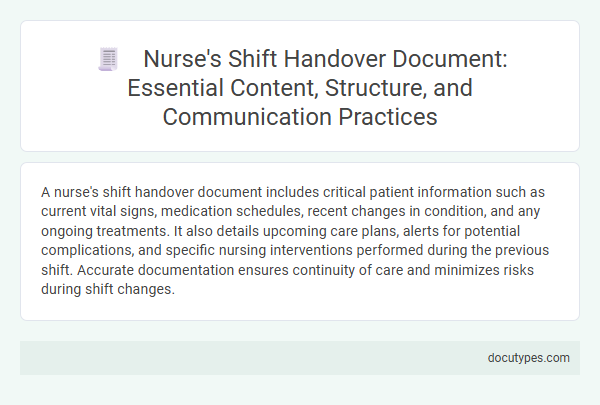A nurse's shift handover document includes critical patient information such as current vital signs, medication schedules, recent changes in condition, and any ongoing treatments. It also details upcoming care plans, alerts for potential complications, and specific nursing interventions performed during the previous shift. Accurate documentation ensures continuity of care and minimizes risks during shift changes.
Introduction to Nurse’s Shift Handover
A nurse's shift handover document is a critical tool for ensuring continuity of care during shift changes. It contains essential patient information to support safe and effective nursing practices.
This document typically includes patient identification details, current medical conditions, medications, recent treatments, and any changes in patient status. It also records vital signs, allergies, and specific care instructions. Your understanding of the handover content is vital for maintaining patient safety and making informed decisions during your shift.
Importance of Accurate Handover Documentation
Accurate handover documentation in nursing ensures continuity of care and patient safety by providing comprehensive information about the patient's condition, treatment plans, and any recent changes. It includes vital signs, medication administration details, ongoing interventions, and specific patient needs or concerns.
Precise shift handovers reduce the risk of errors, prevent omissions in care, and facilitate effective communication among healthcare professionals. Clear documentation supports clinical decision-making and helps maintain accountability throughout the patient's hospital stay.
Essential Content of the Handover Document
A nurse's shift handover document includes essential patient information such as current medical conditions, ongoing treatments, and recent changes in health status. It details medication schedules, allergies, vital signs, and any interventions performed during the previous shift. The document also highlights critical care instructions, pending tests, and special patient needs to ensure continuity of care and patient safety.
Structured Formats for Handover Notes
| Section | Details Included | Purpose |
|---|---|---|
| Patient Identification | Name, age, medical record number, and room number | Ensures the right patient information is communicated to avoid errors |
| Medical History & Diagnosis | Current diagnosis, past medical history, allergies, and significant comorbidities | Provides context for ongoing care and highlights potential risks |
| Current Condition | Vital signs, pain level, neurological status, and any recent changes | Updates on patient's stability and alerts to monitor specific parameters |
| Medications & Treatments | Current medications including dosages, times, and recent changes; ongoing treatments and procedures | Ensures continuity and accuracy in medication administration and therapy |
| Care Plans & Interventions | Planned nursing interventions, mobility status, nutritional needs, and wound care | Guides nursing actions and prioritizes patient-centered care activities |
| Safety & Alerts | Fall risk, infection control precautions, equipment needs, and behavioral concerns | Highlights safety risks and specific precautions to maintain patient safety |
| Communication & Documentation | Notes on family updates, outstanding tests or labs, and pending physician orders | Keeps all staff informed and ensures follow-up on critical tasks |
| Structured Format Examples | SBAR (Situation, Background, Assessment, Recommendation), ISBAR, SOAP notes | Provides a standardized framework for clear, concise, and efficient handover communication |
You benefit from using structured handover formats because they reduce miscommunication, improve patient safety, and enhance continuity of care during nursing shift changes.
Standardized Communication Tools (e.g., SBAR)
What information is included in a nurse's shift handover document? A nurse's shift handover document contains critical patient details such as current condition, ongoing treatments, medication schedules, and any recent changes in status. Standardized communication tools like SBAR (Situation, Background, Assessment, Recommendation) ensure the information is clear, concise, and effectively transferred.
Patient Safety and Risk Management
A nurse's shift handover document is essential for maintaining patient safety and effective risk management during care transitions. Clear and accurate information transfer helps prevent errors and ensures continuity of care.
- Patient Identification - Includes full name, date of birth, and hospital ID to ensure correct patient matching and prevent treatment errors.
- Current Health Status - Details vital signs, symptoms, and recent changes to monitor risks and guide immediate care needs.
- Medication and Allergies - Lists prescribed drugs, dosages, and any known allergies to avoid adverse drug interactions and allergic reactions.
Confidentiality and Legal Considerations
Nurse's shift handover documents contain critical patient information that must be handled with strict confidentiality to protect patient privacy. Legal considerations require accurate, detailed, and secure documentation to ensure accountability and compliance with healthcare regulations.
- Confidentiality of Patient Data - Ensures sensitive information is shared only with authorized personnel to prevent unauthorized access and breaches.
- Accurate Record-Keeping - Provides a precise and thorough account of patient care, supporting continuity and reducing the risk of medical errors.
- Compliance with Regulations - Adheres to laws such as HIPAA and GDPR, mandating secure handling and storage of patient records.
Maintaining confidentiality and legal compliance in nurse shift handover documents safeguards patient trust and upholds professional standards in healthcare.
Common Handover Errors and Solutions
Nurse's shift handover documents typically include patient identification, current medical status, medication schedules, recent changes in condition, and care plans. Accurate and thorough documentation ensures continuity of care and patient safety during shift changes.
Common handover errors include incomplete information, miscommunication, and omission of critical details such as allergy status or pending test results. Solutions involve using standardized templates, implementing verbal confirmations, and conducting focused training on effective communication techniques.
Best Practices for Effective Handover
A nurse's shift handover document includes patient vital signs, medication schedules, recent changes in condition, and care plans to ensure continuity. Clear, concise communication and standardized formats like SBAR (Situation, Background, Assessment, Recommendation) enhance accuracy and reduce errors. Best practices emphasize timely updates, verification of critical information, and collaborative discussions between incoming and outgoing nurses to promote patient safety.
What Information Is Included in a Nurse’s Shift Handover Document? Infographic

